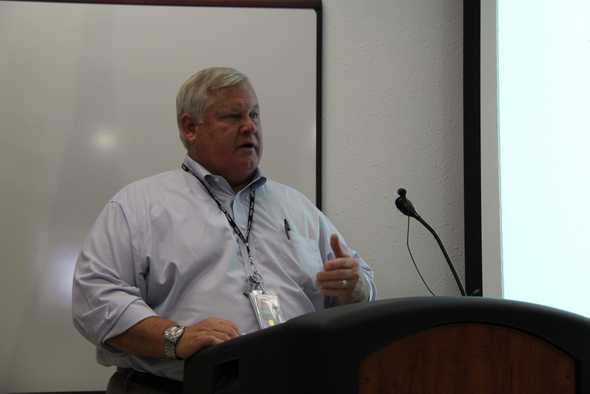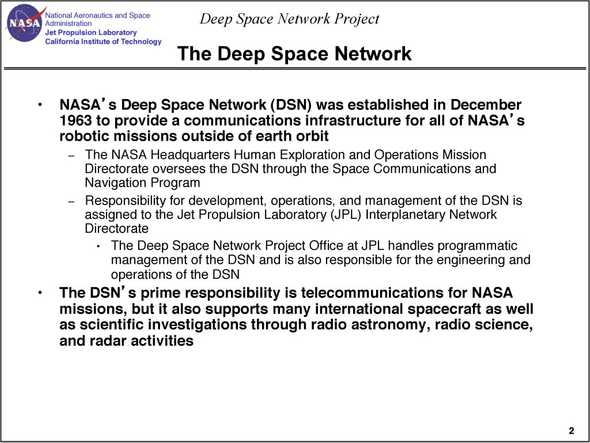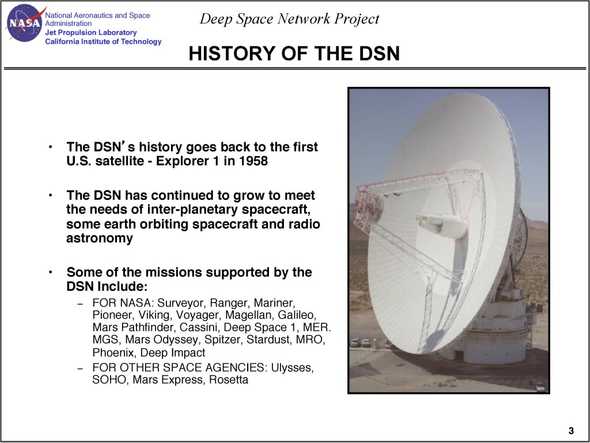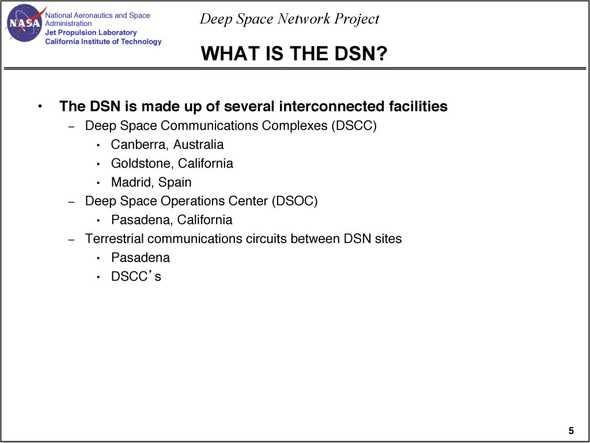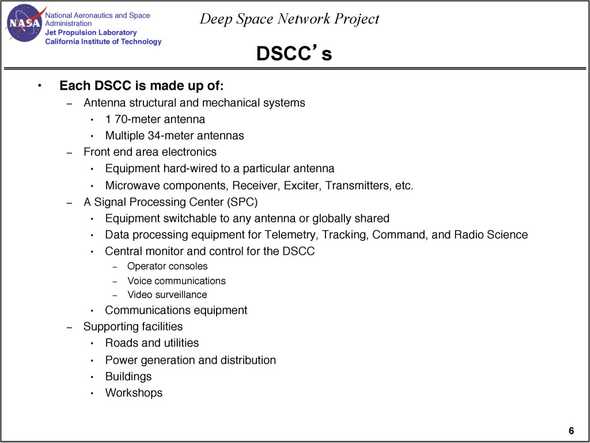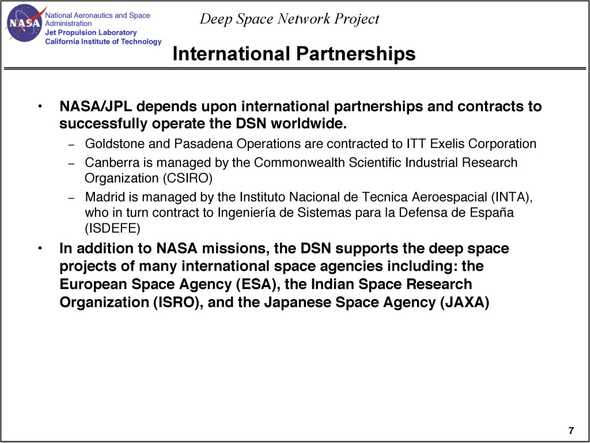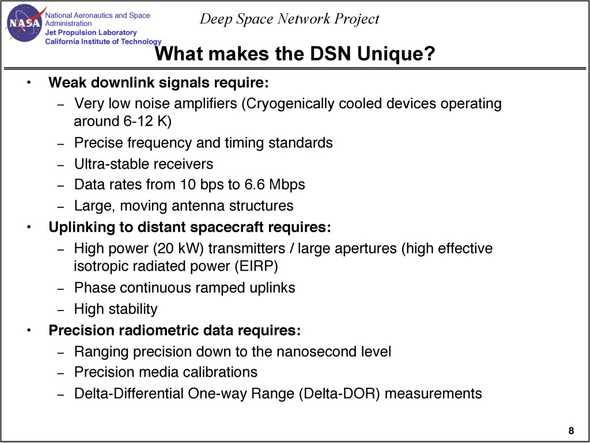Goldsone #DSN: Wayne Sible
The second speaker at the Goldstone deep Space Network NASA Social was Deputy Project Manager Wayne Sible. Sible talked about the missions that the Deep Space Network (DSN) supports and what each Deep Space Communications Complex (DSCC) has to offer.
NASA’s Deep Space Network was established in December 1963 to provide a communications infrastructure for all of NASA’s robotic missions outside of earth orbit. The NASA Headquarters Human Exploration and Operations Mission Directorate oversees the DSN through the Space Communications and Navigation Program. The Jet Propulsion Laboratory (JPL) Interplanetary Network Directorate is responsible for development, operations, and management of the DSN. The Deep Space Network Project Office at JPL handles programmatic management of the DSN and is also responsible for the engineering and operation of the DSN.
The primary responsibility of the DSN is telecommunications for NASA missions, but it also supports many international spacecraft as well as scientific investigations through radio astronomy, radio science, and radar activities.
Once a spacecraft is past the moon, the only way to communicate back to Earth is through the DSN. It is important to have a network that is responsive, reliable, and fault-tolerant. When the Mars Curiosity Laboratory landed on Mars, the Goldstone Complex and Australian complex had overlapping coverage of the spacecraft. The Australian complex was running on backup power generators during the landing. Alternate assets from the European Space Agency were also used in tracking the spacecraft. Closer to the red planet, the Mars Reconnaissance Orbiter and Mars Odyssey were tracking the spacecraft and relaying data back to the DSN. Sible said they take their responsibility very seriously tracking about $23 billion worth of assets that rely on the DSN for the health and safety of the spacecrafts.
Currently, there are 100 antenna under construction at the Canberra complex. Each complex has a 70m antenna. A high-efficiency antenna, the predecessor to the beam waveguide antenna, have their electronics up inside the cone. Three beam waveguide antennas are being built in Australia, two in Madrid, and one for Goldstone to provide a backup to the 70m antennas should they go offline for planned maintenance or unplanned reasons.
At Goldstone, they undertook a massive effort lifting the antenna, replaced the runner and grout. National Geographic’s World’s Toughest Fixes produced an episode about the repairs. They are planning to replace the grout at the 70m antennas at the Australian and Spain complexes that will help with longterm maintenance.
The DSN’s history goes back to the first U.S. satelite in 1958, Explorer 1. The DSN has continued to grow to meet the needs of inter-planetary spacecraft, some earth orbiting spacecraft and radio astronomy. Surveyor, Ranger, Mariner, Pioneer, Viking, Voyager, Magellan, Galieo, Mars Pathfinder, Cassini, Deep Space 2, MER, MGS, Mars Odyssey, Spitzer, Stardust, Mars Reconnaissance Orbiter, Phoenix, Deep Impact, Ulysses, Solar and Heliospheric Observatory, Mars Express, and Rosetta are some of the missions supported by the DSN.
Because missions stay around, sometimes years beyond their expected lifetime, the DSN has to maintain the capabilities to support the various protocols used while advancing capabilities to support new missions.
The DSN has three functions: telecommunication, navigation, and science. The bread and butter of the DSN, telecommunications, is used to send commands and receive data back. The uplink uses 20KW Transmitters, S-band (2GHz) and X-band (8Ghz) with data rates from 10bps to 10Kbps. The downlink uses S-band (2Ghz) and X-band (8GHz), Ka-band (26 or 32 Ghz) with data rates from 10bps to 6.6 Mbps. The second function, navigation, collects multiple data types used for orbit determination: range, doppler, angles, delta-DOR, and Very Long Baseline Interferometry (VLBI). The third function, science, is where the DSN uses radar to bounce a radio signal off a celestial body and processes the received reflected signal, radio science where observations of changes in a spacecraft radio signal as it passes through a planetary atmosphere, and radio astronomy where observations of naturally occurring radio emissions.
Each of the three sites have a 70m antenna and multiple 34m high-effiency antenna. There are five beam waveguide antennas at Goldstone, two in Spain, and one in Australia. In 2015, celestial dynamics will require coverage in the Southern Hemisphere.
Most of the data is received at and distributed from JPL. There is an alternate emergency control center at Goldstone should the JPL location go down as it did when the Station Fire in Southern California forced an evacuation at JPL a few years ago.
Each DSCC has front end area electronics hard-wired to a particular antenna; a Signal Processing Center (SPC) that can be switched to any antenna or globally shared; data processing equipment for Telemetry, Tracking, Command, and Radio Science; central monitor and control for the DSCC with operator consoles, voice communications, and video surveillance; and utilities, power generation and distribution, buildings, and workshops. It costs about ten thousand dollars a day in fuel to run the backup power generators in Australia.
The DSN has International partnerships with the European Space Agency (ESA), the Indian Space Research Organization (ISRO), and the Japanese Space Agency (JAXA). On a normal basis they support about three dozen missions. Another dozen were supported during launch, handed off to their primary network, and are supported on an emergency basis as needed. The large antennas at the DSN can be helpful for getting a signal to a spacecraft when a problem occurs.
The DSN can only transmit to Voyager 1 from the Southern hemisphere, so the Australian DSCC is very important for that mission. Voyager and missions in safe mode transmit with the 10bps data rates. In safe mode, or emergency mode, missions can send basic housekeeping information home to let mission control know the status of the spacecraft.
A question was asked what benefits do partner countries get for having a DSCC located in their country. Sible said that when the infrastructure is upgraded or expanded, local companies and workforce are used and benefit financially. The land where the DSCCs are located are owned by the government and leased. The facilities are owned by NASA.
Sible shared two things that keep him up at night. The first is the safety of the engineers and personnel who climb on and work around the large antennas. There are plenty of safety protocols that keep them safe but there are risks. The second is failure the moment when a mission relies on the DSN. For some unexpected reason, that the DSN would be unable to support and save a mission in an emergency. In other words, they worry about the reliability of the network and ensuring there are backups in place.
The video of Sible talking is below:

